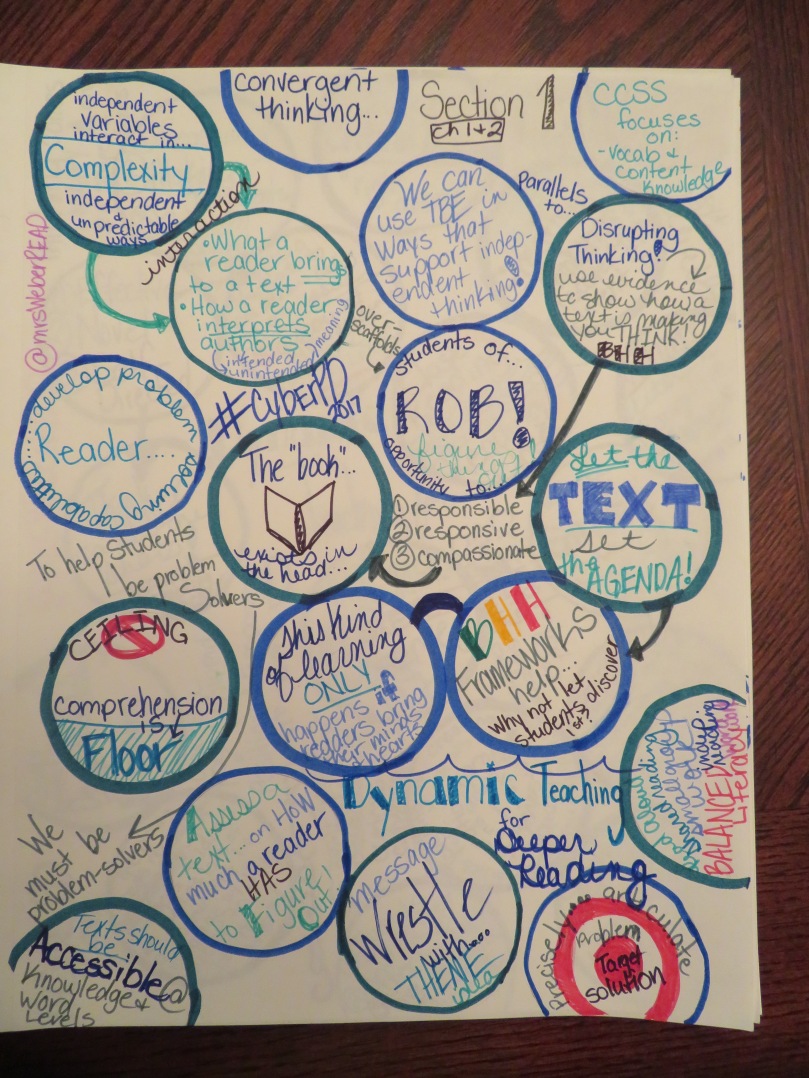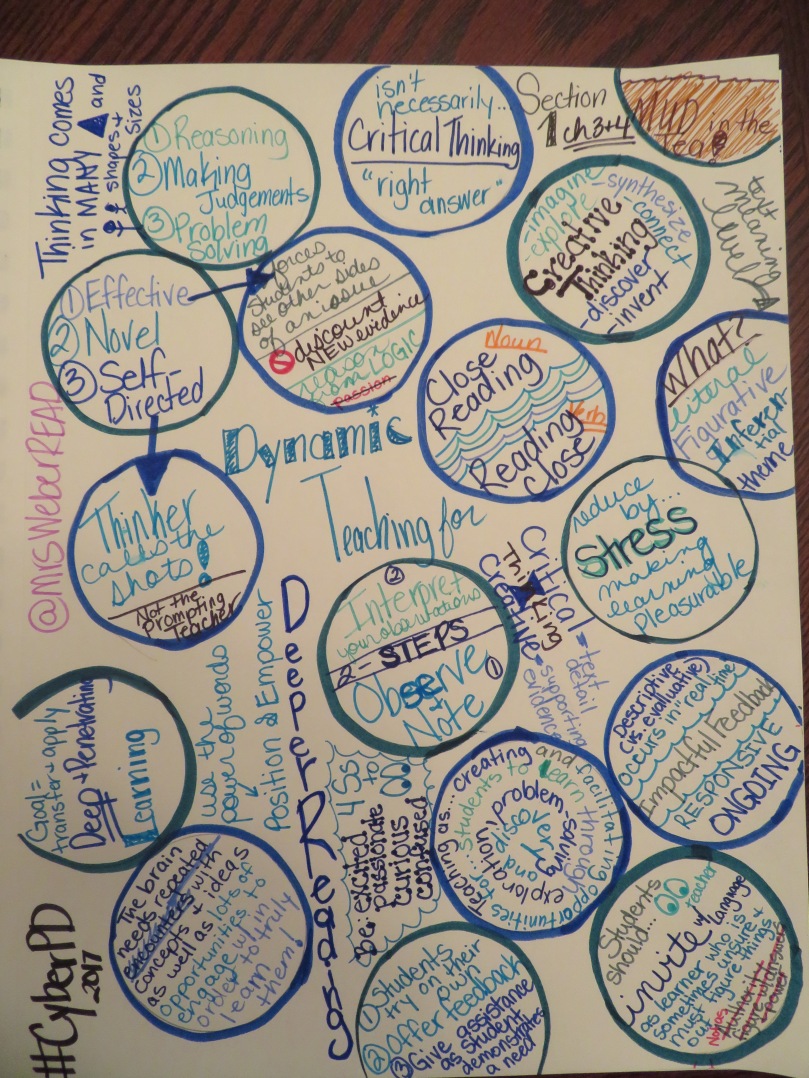

Section one was a great way to dive into this topic and I found the text is pairing nicely with the other summer PD book I am studying, Disrupting Thinking. The need to develop readers that can think deeply (Vinton), be responsible, be responsive, and be compassionate (Beers & Probst) is critical.
As a gifted intervention specialist, the view of “text complexity” has always been a hot topic. Parents are often concerned that their child is not reading “challenging enough” texts. Given that the chronological age, emotional age, and reading ability of my children is extremely mismatched, I find I advise parents often to not look at the “level” of the text as a measure. My students can read high lexile leveled text because they have the ability. But they often do not have the maturity to handle the topics, themes, and situations presented in texts that are push their vocabularies. This is why I turn to picture books. And this is why I felt so affirmed by Vicki Vinton’s call for teachers to re-evaluate what “complexity” means. Complexity is about the variables a reader brings to a text… I love it! My students can be challenged by the simplicity of Matt de la Pena’s Last Stop on Market Street because they can work through the meaning. They live in suburbia, in a predominantly “white” town with varying levels of affluence. To relate to an inner-city child of color is a stretch. Sometimes my students are more challenged by plot and character than they ever are by vocabulary and their content knowledge!
The idea of convergent thinking also resonated with me. I have always been ‘resistant’ to explicitly stating learning objectives to students at the beginning of lessons and I still am. I have found learning for my students to be more powerful when they uncover it. If I tell them what they are going to learn, then they often stop there. However if I present an opportunity for them discover and put pieces together on their own, not only do they almost always learn what I had hoped but they learn more than I could have ever imagined. I feel that we uncover what we need when we truly let a ‘text set an agenda’.
So here is where I make another connection to Distrupting Thinking…the idea of reading with a “book-head-heart” framework. (More info here: https://hwlearninglinks.wordpress.com/2017/06/19/disrupting-thinking-3/) If we arm students with some simple ideas, they will develop those problem solving capabilities that we know they need. If we ‘overscaffold’ and feed students too much info, then we do “rob students of fully experiencing…rob them of the opportunity to figure things out themselves…” (Vinton pg. 10).
Thus when Vinton asserts that we should “assess text complexity by how much a reader has to figure out that the writer has conveyed directly” (pg. 22) I am like YES!!!! This is what I have been trying to tell parents for years! Our children need the opportunity to ‘wrestle with a text’s message, idea, or theme’ and through that struggle they are challenged, changed, or perhaps confirmed in what they know (Beers & Probst).
Many parts of this section just grabbed me. Rather than quote them all however I think I will just share the two pages of sketchnotes I created as I contemplated and reflected on what I took in. I am inspired and eager to grow further!

YES!! “However if I present an opportunity for them discover and put pieces together on their own, not only do they almost always learn what I had hoped but they learn more than I could have ever imagined.” I am in the process of gathering my thinking and getting ready to blog. You already have me going back into the book.
So much to think about and consider!
Love your sketch notes!
At any point in reading (text, art, movie) a student could hit a snag in understanding. How do they “right themselves and get back into the learning? That’s what is important for ALL students – whether TAG, EL, with an IEP!
Thank you Fran! I love that sketchnoting engages multiple modes and find that students find sketching powerful ways to process and work through their thinking. I love that you refer to reading as more than just the text (art, movie) and I’ll add audio. My definition of reading has expanded to interaction with the message another is giving us whether that be words or images.
How do students right themselves and get back into the learning? Great question! I loved that you mentioned ‘overscaffolding’ and ‘priming the pump’ in your post and I think that is our challenge. How do we help guide our students back into the learning without guiding them too much? Perhaps I feel I do this by giving students permission to grapple with ideas and honor any thinking they do. This gives them confidence to keep trying. Maybe it is through persistence that they right themselves… You give me plenty to think about!
I’m using some sketch noting this summer, but it truly is baby steps. I love taking electronic notes so I’m working on expanding sketchnoting and also trying to write so that my words are in the “readable” category!
My former life as a special ed. teacher – I really did rush in and rescue rather than let students grapple and struggle. It wasn’t a lack of confidence but I really thought that was what I was supposed to do! UGGGHHHHH!!!
I am loving the sketchnotes, especially the circles method to highlight a variety of ideas that come out of the reading. As a librarian, the push/pull between text complexity and reading levels is a constant one in my interactions with students, teachers and parents. Everybody wants something different. So much more thinking to do.
Picture books are invaluable. They can be quite complex and there are so many with important themes. I love Vicki Vinton’s ideas about text complexity. It’s not all about a harder text, but about the thinking we support students in doing about that text. Love your sketch notes!
These sketchnotes are wonderful, Heidi. I like the organization of them and the way you captured your most important thinking. I also saw some powerful connections to Disrupting Thinking, particularly in using the BHH framework to help students go beyond the four corners of the page and read with their mind and their heart. I also related to the SWBAT discussion as well. My preservice teachers are so accustomed to these kinds of objectives that they have a hard time with broader thinking about their lesson goals when they arrive in graduate school. I think sharing this section of the book with them will help give them another perspective. Such great reflections!
Stephanie
I loved this: “The need to develop readers that can think deeply (Vinton), be responsible, be responsive, and be compassionate (Beers & Probst) is critical.” Your work alongside gifted students is quite interesting to consider as we talk about complex texts vs. complex thinking. I’ve seen kids get to complex thinking in the simplest of books. I’m so glad you are joining us again this year. I always look forward to learning from you.
Cathy
Heidi, I’m enthralled with this version of sketchnoting!!! (Is that a word yet?) I like the simplicity of the circles and filling in the important points to remember or questions … that blank page terrifies me, especially as a perfectionist in drawing (even when it’s not a true strength!). So … I may have to try this.
Beyond all that, I love the comparisons to Disrupting Thinking. I have that book in my stack to read this summer too and trust me, it was almost the #cyberPD pick (but there was another BIG group reading this title, so ….) This is the ultimate goal: “The need to develop readers that can think deeply (Vinton), be responsible, be responsive, and be compassionate (Beers & Probst) is critical.” I also appreciate your take on text complexity when working with your students — it just makes sense!
Thanks for enthusiastically joining in the #cyberPD conversations again this year! Love seeing and hearing your thoughts and take-aways!